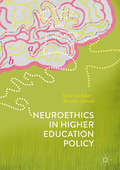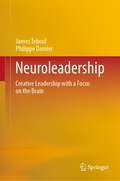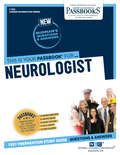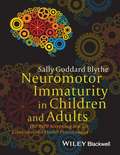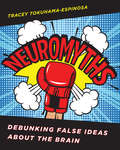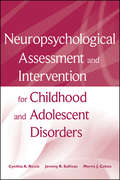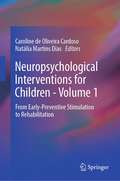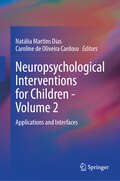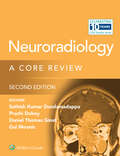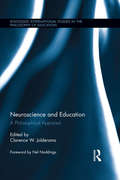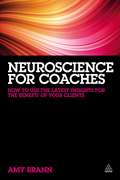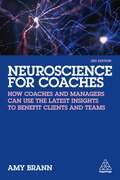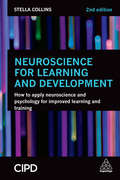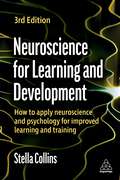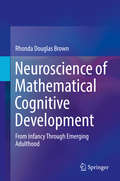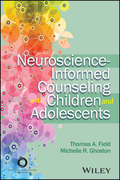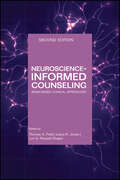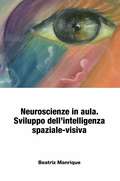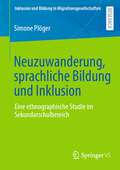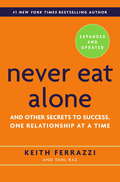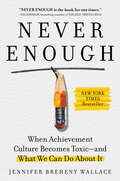- Table View
- List View
Neuroethics in Higher Education Policy
by Dana Lee Baker Brandon LeonardThis book focuses on neuroethics in higher education in the United States. After introducing readers to the philosophical and policy foundations of the neuroethics of higher education, this book explores essential conundrums in the neuroethical practice of higher education in modern democracies. Focusing on neuroethics from the perspective of universally designed learning and policy design sets this project apart from other work in the field. Advances in neuroscience and changes in attitudes towards disability have identified mechanisms by which higher education infrastructures interact with both individuals considered neurotypical and those with identified disabilities to diminish students' capacity to enter, persist, and complete higher education. Policy to date has focused on identified disabilities as a requirement for accommodations. This strategy both underestimates the effect of ill-fitting infrastructures on those considered neurologically typical and serves to stratify the student body. As a result, neuroethical gaps abound in higher education.
Neuroleadership: Creative Leadership with a Focus on the Brain
by James Teboul Philippe DamierThis book illustrates, through a number of examples from different domains, how to put in place a disciplined process to develop a creative leadership approach. Today's managers seem to have all the tools at their disposal, leadership training, seminars and executive coaching, to exercise effective leadership, but most continue to take the easy path of raw authority, neglecting the interwoven texture of leadership and followership. The classic models of leadership fail routinely because leaders find it hard to develop an effective way of motivating their followers and do not realize how far they are conditioned by the limitations and biases hardwired in their brains. Just like sports professionals who need a good understanding of their body, leaders need to practice and explore the capabilities of their brains. With some knowledge in the latest discoveries in Neurosciences and mastery of their cognitive predispositions, leaders can draw on a range of resources to engage all parties in learning and collaborating towards common goals and create a culture based on cooperation and innovation. Ideal for organizations or associations, private or public companies, this book offers practical advice on neuroleadership through examples of successful transformation including a case study at Netflix.
Neurologist: Passbooks Study Guide (Career Examination Series #C-530)
by National Learning CorporationThe Neurologist Passbook® prepares you for your test by allowing you to take practice exams in the subjects you need to study. It provides hundreds of questions and answers in the areas that will likely be covered on your upcoming exam.
Neuromotor Immaturity in Children and Adults
by Sally Goddard BlytheAvailable to healthcare professionals for the first time, this book contains proven screening tests to measure neuromotor immaturity in children and adults in order to provide a basis for referral and help. Allows practitioners to screen for disorders of movement that can negatively affect educational performance and emotional function in children and adolescents Assesses instances where disorders of movement in adults are affecting thoughts and behavior, as in panic disorder Provides a novel approach for health care professionals observing aberrant reflexes in the absence of more serious pathology Includes reproducible scoring and observation sheets for practice and serves as the perfect complement to Assessing Neuromotor Readiness for Learning
Neuromyths: Learning About Teaching By Debunking False Ideas About The Brain
by Tracey Tokuhama-EspinosaA guide to the science behind the art of teaching. Not every teaching method touted as "brain-friendly" is supported by research findings—and misconceptions about the brain have the capacity to harm rather than help. In her new book, Tracey Tokuhama-Espinosa untangles scientific fact from pedagogical fiction, debunking dozens of widely held beliefs about the brain that have made their way into the education literature. In ten central chapters on topics ranging from brain structure to classroom environments, the text traces the origins of common neuromyths—from categorizing individuals as "right-brained" or "left-brained" to prevailing beliefs about multitasking or the effects of video games—and corrects the record with the most current state of knowledge. Rather than offering pat strategies, Tokuhama-Espinosa challenges teachers curious about the brain to become learning scientists, and supplies the tools needed to evaluate research and put it to use in the classroom.
Neuropsychological Assessment and Intervention for Childhood and Adolescent Disorders
by Morris J. Cohen Jeremy R. Sullivan Cynthia A. RiccioA compelling and compassionate case study approach to a broad range of neuropsychological disordersNeuropsychological Assessment and Intervention for Childhood and Adolescent Disorders focuses on the neuropsychological assessment and evidence-based practices available for assessing and treating children living with the etiological and neurological components of various disorders. Each chapter provides one or more case studies along with helpful background information, assessment results, and recommendations based on assessment data.Bridging science and practice, the book reviews the scientific literature, research on clinical implications, and evidence-based treatment of such disorders as:Dyslexia and DyscalculiaSpecific Language Impairment/DysphasiaAutism Spectrum DisordersAttention-Deficit/Hyperactivity DisorderTourette SyndromeTraumatic Brain InjuryChildhood CancerEpilepsyCerebrovascular DiseaseLow Birth WeightEnvironmental Toxin ExposureNeurotoxins, Pregnancy, and Subsequent DisordersChromosomal AnomaliesNeurocutaneous DisordersMetabolic DisordersEach case study complements the content of each chapter by illustrating how the assessment process can inform intervention efforts for children. In addition, the cases humanize the effects of various disorders and demonstrate the usefulness of neuropsychological information in treatment and intervention planning, especially within children's educational and social contexts.
Neuropsychological Interventions for Children - Volume 1: From Early-Preventive Stimulation to Rehabilitation
by Caroline de Oliveira Cardoso Natália Martins DiasThis book is the first of two volumes that aim to serve as a comprehensive guide for professionals working with neuropsychological interventions especially designed for children. This first volume presents the theoretical foundations, tips and guidelines for neuropsychologists to develop different interventions, such as stimulation and early intervention with a focus on promoting neuropsychological health; habilitation, appropriate for work with neurodevelopment disorders; and rehabilitation, in cases of structural alterations. In this sense, it reflects the editors' concern to provide material with practical tips, but theoretically grounded, and truly useful to professionals in clinical and also school contexts. This first volume is divided into two parts. The first addresses the theoretical and practical foundations of child neuropsychological assessment and intervention. Neuropsychological assessment is discussed, with a focus on its role in guiding intervention. Also, different types of interventions are presented, and a taxonomy is offered, according to its differential objectives of promotion or remediation and the target population (typical development, functional or structural alterations of the Nervous System), leading to the suggestion of three types of interventions in neuropsychology in both clinical and school contexts: 1) Early preventive Intervention; 2) Habilitation and 3) Rehabilitation. Cognitive stimulation in different contexts, such as school, family and clinical, is also discussed, exploring how teachers and parents can also collaborate in intervention processes, expanding the possibilities for action beyond the clinical context. A section concludes by addressing the importance of the feedback and the neuropsychological assessment report.The second part focuses specifically on stimulation and rehabilitation, offering chapters that target specific skills such as attention, memory, executive functions and academic skills, among others. The chapters summarize evidence, bring tips and illustrate existing materials and programs, in a continuous articulation between theory-evidence-practice. Originally published in Portuguese and now available in English, Neuropsychological Interventions for Children – Volumes 1 and 2 will be of interest to professionals working with neuropsychology in clinical and school contexts. It will also be useful in neuropsychology teaching contexts (specialization courses in neuropsychology and related areas) and for students and professionals in interface areas, such as Psychology, Education, Speech Therapy, Occupational Therapy among others. The translation of the original Portuguese version of this book into English was done with the help of artificial intelligence. A subsequent human revision was done primarily in terms of content.
Neuropsychological Interventions for Children - Volume 2: Applications and Interfaces
by Caroline de Oliveira Cardoso Natália Martins DiasThis book is the second of two volumes that aim to serve as a comprehensive guide for professionals working with neuropsychological interventions especially designed for children. This second volume complements the theoretical and practical foundations presented in the first volume by presenting applications to different clinical conditions and by exploring interfaces of neuropsychology with other areas of research and practice. Chapters in this second volume are divided into two parts. The first part presents a series of case studies, illustrating the practice and experience of neuropsychological rehabilitation and habilitation in different clinical conditions. The second part brings together chapters that discuss the interfaces of neuropsychology with different areas, which can use its knowledge and interventions (such as school neuropsychology) or which can be used as strategies within neuropsychological intervention or even compose inter and transdisciplinary partnerships in the work of promotion, stimulation, or cognitive remediation, such as the use and role of music, games and play, mindfulness, and transcranial direct current stimulation. So, chapters in this second part highlight the interfaces with other approaches, knowledges or disciplines. Originally published in Portuguese and now available in English, Neuropsychological Interventions for Children – Volumes 1 and 2 will be of interest to professionals working with neuropsychology in clinical and school contexts. It will also be useful in neuropsychology teaching contexts (specialization courses in neuropsychology and related areas) and for students and professionals in interface areas, such as Psychology, Education, Speech Therapy, Occupational Therapy among others. The translation of the original Portuguese version of this book into English was done with the help of artificial intelligence. A subsequent human revision was done primarily in terms of content.
Neuroradiology: A Core Review (A Core Review)
by Prachi Dubey Sathish Kumar Dundamadappa Gul Moonis Daniel Thomas GinetPrepare for success on the neuroimaging component of the radiology Core Exam! Neuroradiology: A Core Review, 2nd Edition, by Drs. Sathish Kumar Dundamadappa, Prachi Dubey, Daniel Thomas Ginat, and Gul Moonis, is an up-to-date, practical review tool written specifically for the Core Exam. This helpful resource contains 500 image-rich, multiple-choice questions with detailed explanations and annotated images of right and wrong answers, fully revised content, high-yield tables for easy review, and additional eBook questions to ensure you’re ready for the Core Exam or recertification exam.
Neuroscience and Education: A Philosophical Appraisal (Routledge International Studies in the Philosophy of Education)
by Clarence W. JoldersmaThis volume makes a philosophical contribution to the application of neuroscience in education. It frames neuroscience research in novel ways around educational conceptualizing and practices, while also taking a critical look at conceptual problems in neuroeducation and at the economic reasons driving the mind-brain education movement. It offers alternative approaches for situating neuroscience in educational research and practice, including non-reductionist models drawing from Dewey and phenomenological philosophers such as Martin Heidegger and Merleau-Ponty. The volume gathers together an international bevy of leading philosophers of education who are in a unique position to contribute conceptually rich and theoretically framed insight on these new developments. The essays form an emerging dialogue to be used within philosophy of education as well as neuroeducation, educational psychology, teacher education and curriculum studies.
Neuroscience for Coaches
by Amy BrannThe world of coaching is competitive. Organisations want coaches who deliver results, and can prove it. Many coaching tools and techniques are now fairly well established - but how do they actually work? The coach who can answer this question credibly and convincingly is sought after. This ground-breaking book equips coaches with cutting edge neuroscience information that will help them deliver greater value to their clients. It covers the foundations that coaches need to be aware of and crucially, the ways they can use this new information effectively and practically in their everyday work. Readers will strengthen their kitbag of coaching tools and will be able to explain to their clients the neurological underpinning of the techniques they are using. No forward-thinking coach can afford to be ignorant of recent scientific developments: Neuroscience for Coaches will give them the practical knowledge they need.
Neuroscience for Coaches: How coaches and managers can use the latest insights to benefit clients and teams
by Amy BrannMany coaching tools and techniques are now well established, but how do they actually work? The third edition of Neuroscience for Coaches answers this question to help coaches and managers deliver greater value to clients and employees.Based on extensive research, Neuroscience for Coaches provides a clear explanation of the aspects of neuroscience that are relevant to coaching so coaches can describe to clients why particular techniques work and the benefits to be gained from using them. It also features interviews with Marshall Goldsmith, Susan Grandfield, Christian van Nieuwerburgh and Kim Morgan on topics including mindfulness and behaviour change in coaching.This fully updated third edition covers the latest neuroscientific research on key brain areas and their functions, such as the Prefrontal cortex and Amygdala which affect attention, processing and emotional regulation. With tips and insights throughout, it crucially demonstrates the ways in which coaches and managers who coach can use this information effectively and practically in their everyday work. Neuroscience for Coaches is a vital resource for improving coaching practice with the latest scientific developments, tools and techniques.
Neuroscience for Coaches: How to Use the Latest Insights for the Benefit of Your Clients
by Amy BrannMany coaching tools and techniques are now fairly well established, but how do they actually work? Neuroscience for Coaches equips coaches with information that will help them answer this question and therefore deliver greater value to clients. Based on over twelve years of research, this book provides a clear explanation of the aspects of neuroscience that are relevant to coaching so you can describe to clients from a neuroscientific perspective why particular techniques and methods work and the benefits to them.This fully updated 2nd edition of Neuroscience for Coaches includes new interviews with Marshall Goldsmith, Susan Greenfield, Christian van Nieuwerburgh and Kim Morgan, along with new material on oxytocin, goals and mindfulness. It covers the latest neuroscientific research and, crucially, the ways in which coaches can use this information effectively and practically in their everyday work. Neuroscience for Coaches is a vital resource for keeping up to date with recent scientific developments, tools and techniques in coaching.
Neuroscience for Learning and Development
by Stella CollinsNeuroscience for Learning and Development is about the psychology and neuroscience that underpins effective and successful training and learning. It introduces the latest research and concepts and suggests practical tools, techniques and ideas to improve how trainers train and how people learn. Readers will find new and more effective ways of working and will discover a sound basis for good practice. They will also discover the research that backs up what they are already doing well and evidence to support future projects and plans in order to make a convincing case to budget holders. Neuroscience for Learning and Development covers the design and delivery of face-to-face, online and virtual learning as well as how to create environments which make learning easier. It provides evidence to stop training and learning being seen as 'soft and fluffy' and will help trainers and L&D teams persuade the rest of their organization of their value. This book explains the science behind creative training delivery so that learners will be motivated, enjoy training, pay attention, remember what they learn and be able to apply it back at work. It explains the neuroscience of attention, memory and habits and how to make sure people learn what they need to learn. Readers will be able to distinguish the neuromyths from the neuroscience and will find out which elements of brain science offer evidence for current practice and as well as discovering new ideas to continue to develop their skills and practice.
Neuroscience for Learning and Development: How to Apply Neuroscience and Psychology for Improved Learning and Training
by Stella CollinsIn order to design and deliver effective Learning and Development (L&D) initiatives, it is essential to understand how our brains work to learn, process and retain information. Neuroscience for Learning and Development introduces the latest research and concepts in the field, equipping learning and development and training professionals with an understanding of some of the inner workings of the mind. Covering areas such as how to create effective learning environments, promoting motivation and how to make learning 'stickier' through using stories and narratives, this book offers practical tools and ideas that can be applied in a variety of contexts, from training sessions and coaching conversations, to lectures and presentations. Featuring insights from L&D practitioners who have applied such approaches in practice, readers will not only find new techniques to implement right away, but also discover the research that backs up what they are already doing well, enabling them to make convincing cases to budget holders.This updated second edition of Neuroscience for Learning and Development contains new chapters on digital learning and the importance of rest and sleep, as well as updated wider content and new material on mindfulness, learning through your senses, and the neuroscience of habits.
Neuroscience for Learning and Development: How to Apply Neuroscience and Psychology for Improved Learning and Training
by Stella CollinsNeuroscience for Learning and Development provides L&D professionals the tools and ideas to design and deliver effective initiatives with knowledge of how our brains process information.Using the latest research and concepts, this book covers areas such as motivation, habits and the link between sleep and learning. It demonstrates how to create effective learning environments and make learning 'stickier' with advancements in AI and digital learning, and through the use of stories. The practical tools and guidance can be applied in different contexts, such as digital learning, in-person training sessions and presentations.The third edition contains a new chapter on creating an autonomous learning culture. It explains the strategies, tools and techniques L&D professionals can use to encourage and support employees to learn in the flow of work. With insights from L&D practitioners who have applied these approaches in organizations such as The Open University, this edition is an indispensable book for creating and maintaining workplace learning that benefits people and organizations.
Neuroscience of Mathematical Cognitive Development: From Infancy Through Emerging Adulthood
by Rhonda Douglas BrownThis book examines the neuroscience of mathematical cognitive development from infancy into emerging adulthood, addressing both biological and environmental influences on brain development and plasticity. It begins by presenting major theoretical frameworks for designing and interpreting neuroscience studies of mathematical cognitive development, including developmental evolutionary theory, developmental systems approaches, and the triple-code model of numerical processing. The book includes chapters that discuss findings from studies using neuroscience research methods to examine numerical and visuospatial cognition, calculation, and mathematical difficulties and exceptionalities. It concludes with a review of mathematical intervention programs and recommendations for future neuroscience research on mathematical cognitive development.Featured neuroscience research methods include:Functional Magnetic Resonance Imaging (fMRI). Diffusion Tensor Imaging (DTI).Event Related Potentials (ERP).Transcranial Magnetic Stimulation (TMS).Neuroscience of Mathematical Cognitive Development is an essential resource for researchers, clinicians and related professionals, and graduate students in child and school psychology, neuroscience, educational psychology, neuropsychology, and mathematics education.
Neuroscience-Informed Counseling with Children and Adolescents: A Guide To Neuroscience-informed Practice
by Thomas Field Michelle Ghoston“This is a serious yet understandable book that needs to be on every counselor’s bookshelf. It makes a superb text for child and adolescent counseling courses or an excellent supplementary resource for theories courses. The case material is outstanding, and professors will find the content alignment with the CACREP Standards particularly helpful. The broad expertise of the authors speaks to a general audience, and they provide accurate, clear, and relevant information on neuroscience that is immediately useful. In short, this is a significant contribution to our profession.” —Allen E. Ivey, EdD, ABPP Distinguished University Professor (Emeritus) University of Massachusetts Amherst “This groundbreaking and comprehensive text is a must-have for any helping professional who works with today’s youth. This powerful resource contains the latest knowledge and research about neurocounseling and neuroscience, and the neuro-informed strategies and techniques are particularly helpful. This book is one that you will definitely want in your library.” —Lori A. Russell-Chapin, PhD Bradley University This innovative text is the first to illustrate how neuroscience concepts can be translated and applied to counseling with children and adolescents. Drs. Field and Ghoston discuss general principles for child and adolescent counseling before examining neurophysiological development from birth to age 18. They then provide in-session examples of neuroscience-informed approaches to behavior modification, play therapy, cognitive behavior therapy, biofeedback, neurofeedback, and therapeutic lifestyle change with diverse clients in a variety of settings. Each chapter contains knowledge and skill-building material for counselors-in-training; counselor educators; and practitioners in schools, hospitals, residential facilities, and outpatient clinics. Text features include learning objectives, alignment with the CACREP Standards specific to child and adolescent counseling, explanatory diagrams, reflection questions to prompt deep processing of the material, case vignettes to demonstrate how to apply neuroscience concepts to counseling work, and quiz questions to test knowledge of key concepts. In addition, the text includes an extensive neuroscience glossary. *Requests for digital versions from the ACA can be found on wiley.com. *To request print copies, please visit the ACA website here. *Reproduction requests for material from books published by ACA should be directed to permissions@counseling.org Thomas A. Field, PhD, is an assistant professor of psychiatry in the Mental Health Counseling and Behavioral Medicine program at Boston University School of Medicine. Michelle R. Ghoston, PhD, is an assistant professor at Wake Forest University in Winston-Salem, North Carolina.
Neuroscience-Informed Counseling: Brain-Based Clinical Approaches
by Lori A. Russell-Chapin Thomas A. Field Laura K. JonesAs professional counselors learn more about neuroscience, they need guidance on how to integrate this new knowledge into counselor education and counseling practice with clients. The purpose of this updated edition is to provide a comprehensive resource for translating and applying neuroscientific concepts to the theory and practice of counseling. The authors provide guidance as to how counselors integrate neuroscience into their work, with the hope of better understanding and identifying methods for effectively and responsibly incorporating key principles of neuroscience into the profession. This new edition incorporates the 2024 CACREP Standards as markers of learning, to ensure that CACREP-accredited programs have the information needed to apply neuroscientific concepts to all the major areas of counseling practice. This volume addresses the 2024 entry-level educational standards of the main accrediting body of the counseling profession, CACREP. Each of the eight common core areas of counseling knowledge and skills are covered (professional counseling orientation, social and cultural foundations, human growth and development, career development, helping relationships, group counseling and group work, testing and assessment, research and program evaluation). Several 2024 CACREP Standards that are integrated into the eight common core standards, such as the impact of crises, disaster, and traumatic events; the neurobiology of addictions; wellness and optimal performance; and psychopharmacology are also addressed. Some chapters also focus on doctoral-level 2024 CACREP standards for counselor education and supervision. To purchase print copies, please visit the ACA Store. Reproduction requests for material from books published by ACA or any other questions about ACA Publications should be directed to publications@counseling.org. ACA no longer provides complimentary print desk copies. Digital evaluation copies may be requested from Wiley by clicking the link above and completing the details about your institution and course.
Neuroscienze in aula. Sviluppo dell’intelligenza spaziale-visiva.
by Giuseppina De Vita Beatriz ManriqueL’obiettivo centrale del testo è quello di facilitare l’accesso al discorso sulla neuroscienza e come utilizzarla in aula, principalmente attraverso lo sviluppo dell’intelligenza spaziale-visiva proposta tanto da Gardner come da Beauport, due teorici delle intelligenze multiple. Si sviluppa l’uso della visualizzazione, l’abilità per arrivare all’astrazione degli spazi, come opzione di attività in classe progettate nell’ottica di un’educazione integrale. I temi presentati sono organizzati in nove parti: l’introduzione, un’intervista a una famosa maestra, la bilateralità cerebrale, un modello di analisi che parte dall’insegnamento delle lingue, il lavoro con le immagini, l’intelligenza visiva e la creatività, le immagini in aula, una proposta di attività con immagini e le conclusioni. In ciascuna parte si sviluppano differenti aspetti relazionati all’applicazione delle neuroscienze in una classe di lingue straniere, ma solo come esempio di applicazione poiché che l’obiettivo dell’autrice è di presentare, in maniera chiara, l’applicabilità della neuroscienza a tutte le aree di insegnamento e con molti esempi che facilitino l’estrapolazione dell’informazione ad altri campi. L’intervista con una maestra venezuelana di larghe vedute - Alicia Steiner – è uno dei migliori esempi, poiché mostra di fatto che quando si vuole, ci si prepara e si agisce, si raggiungono gli obiettivi. Le pratiche che vengono suggerite e gli esercizi che vengono descritti sono stati utilizzati in aula dalla stessa autrice, che offre la possibilità di espandere il loro utilizzo ad altre aree. Infine, nel testo sono raccolte varie attività visive come esempi di possibile utilizzo nel primo giorno di lezione. Le conclusioni includono, inoltre, riflessioni su tutto il processo del lavoro del docente secondo questo metodo.
Neuzuwanderung, sprachliche Bildung und Inklusion: Eine ethnographische Studie im Sekundarschulbereich (Inklusion und Bildung in Migrationsgesellschaften)
by Simone PlögerDie Studie untersucht, wie neu zugewanderte Schüler*innen an einer Hamburger Sekundarschule integrativ, d.h. sowohl in Regelklassen als auch einer Vorbereitungsklasse, beschult werden. Anhand von ethnographischen Daten wird durch Auswertungsmethoden der Reflexiven Grounded Theory aufgezeigt, wie es zu Prozessen der Inklusion und Exklusion durch sprachliche Bildung kommt. Herausforderungen zeigen sich in strukturell-organisationalen Hürden, während sich Chancen durch das inklusive Selbstverständnis der Schule ergeben, die ihren Unterricht an eine diverse Schüler*innenschaft angepasst hat. So hängt die Möglichkeit der Teilhabe am Regelunterricht letztlich vor allem von Faktoren ab, die alle Schüler*innen gleichermaßen und nicht nur neu zugewanderte betreffen.
Nevada Driver's Handbook
by Nevada Department of Motor Vehicles<p>This handbook has been written in an informal style for easy reading. As you read, you will find information on the knowledge, skills, abilities and attitudes you need to drive safely. <p>You will also find general licensing requirements, some basic traffic laws, explanations of signs and signals, material on driving under the influence and defensive driving tips. The knowledge test for your Nevada license is based on the information in this manual. <p>However, this handbook does not give the exact wording of traffic laws and it does not discuss all of them. For specific laws, please refer to the Nevada Revised Statutes (NRS). NRS copies are available in the public libraries and online at leg.state.nv.us/law1.cfm</p>
Never Do Anything, Ever (Dear Dumb Diary #4)
by Jim BentonHer best friend's a backstabber. Her worst enemy is a sweetheart. And her dog is just waiting for the right moment to seek his revenge. Why should Jamie even bother going to school? Why not? After a run-in with Mega-Popular Angeline, aka Pure Evil, Jamie reforms her selfish ways and becomes the decent human being she never thought she could be. But she quickly realizes that helping others kind of stinks. Is someone trying to thwart her attempts at irresistible inner beauty? Or will Jamie finally achieve the "I'm an angel" glow she knows will make Hudson Rivers fall madly in love with her?
Never Eat Alone, Expanded and Updated: And Other Secrets to Success, One Relationship at a Time
by Keith Ferrazzi Tahl RazThe bestselling business classic on the power of relationships, updated with in-depth advice for making connections in the digital world. Do you want to get ahead in life? Climb the ladder to personal success? The secret, master networker Keith Ferrazzi claims, is in reaching out to other people. As Ferrazzi discovered in early life, what distinguishes highly successful people from everyone else is the way they use the power of relationships—so that everyone wins. In Never Eat Alone, Ferrazzi lays out the specific steps—and inner mindset—he uses to reach out to connect with the thousands of colleagues, friends, and associates on his contacts list, people he has helped and who have helped him. And in the time since Never Eat Alone was published in 2005, the rise of social media and new, collaborative management styles have only made Ferrazzi&’s advice more essential for anyone hoping to get ahead in business. The son of a small-town steelworker and a cleaning lady, Ferrazzi first used his remarkable ability to connect with others to pave the way to Yale, a Harvard M.B.A., and several top executive posts. Not yet out of his thirties, he developed a network of relationships that stretched from Washington&’s corridors of power to Hollywood&’s A-list, leading to him being named one of Crain&’s 40 Under 40 and selected as a Global Leader for Tomorrow by the Davos World Economic Forum. Ferrazzi&’s form of connecting to the world around him is based on generosity, helping friends connect with other friends. Ferrazzi distinguishes genuine relationship-building from the crude, desperate glad-handing usually associated with &“networking.&” He then distills his system of reaching out to people into practical, proven principles. Among them: Don&’t keep score: It&’s never simply about getting what you want. It&’s about getting what you want and making sure that the people who are important to you get what they want, too. &“Ping&” constantly: The ins and outs of reaching out to those in your circle of contacts all the time—not just when you need something. Never Eat Alone: The dynamics of status are the same whether you&’re working at a corporation or attending a social event—&“invisibility&” is a fate worse than failure. Become the &“King of Content&”: How to use social media sites like LinkedIn, Twitter, and Facebook to make meaningful connections, spark engagement, and curate a network of people who can help you with your interests and goals. In the course of this book, Ferrazzi outlines the timeless strategies shared by the world&’s most connected individuals, from Winston Churchill to Bill Clinton, Vernon Jordan to the Dalai Lama. Chock-full of specific advice on handling rejection, getting past gatekeepers, becoming a &“conference commando,&” and more, this new edition of Never Eat Alone will remain a classic alongside alongside How to Win Friends and Influence People for years to come.
Never Enough: When Achievement Culture Becomes Toxic—and What We Can Do About It
by Jennifer Breheny WallaceThe definitive book on the rise of “toxic achievement culture” overtaking our kids' and parents' lives, and a new framework for fighting back. <p><p> In the ever more competitive race to secure the best possible future, today’s students face unprecedented pressure to succeed. They jam-pack their schedules with AP classes, fill every waking hour with resume-padding activities, and even sabotage relationships with friends to “get ahead.” Family incomes and schedules are stretched to the breaking point by tutoring fees and athletic schedules. Yet this drive to optimize performance has only resulted in skyrocketing rates of anxiety, depression, and even self-harm in America’s highest achieving schools. Parents, educators, and community leaders are facing the same quandary: how can we teach our kids to strive towards excellence without crushing them? <p><p> In Never Enough, award-winning reporter Jennifer Breheny Wallace investigates the deep roots of toxic achievement culture, and finds out what we must do to fight back. Drawing on interviews with families, educators, and an original survey of nearly 6,000 parents, she exposes how the pressure to perform is not a matter of parental choice but baked in to our larger society and spurred by increasing income inequality and dwindling opportunities. As a result, children are increasingly absorbing the message that they have no value outside of their accomplishments, a message that is reinforced by the media and greater culture at large. <p><p> Through deep research and interviews with today’s leading child psychologists, Wallace shows what kids need from the adults in the room is not more pressure, but to feel like they matter, and have intrinsic self-worth not contingent upon external achievements. Parents and educators who adopt the language and values of mattering help children see themselves as a valuable contributor to a larger community. And in an ironic twist, kids who receive consistent feedback that they matter no matter what are more likely to have the resilience, self-confidence, and psychological security to thrive. <p><p> Packed with memorable stories and offering a powerful toolkit for positive change, Never Enough offers an urgent, humane view of the crisis plaguing today’s teens and a practical framework for how to help. <p> <b>New York Times Bestseller</b>
